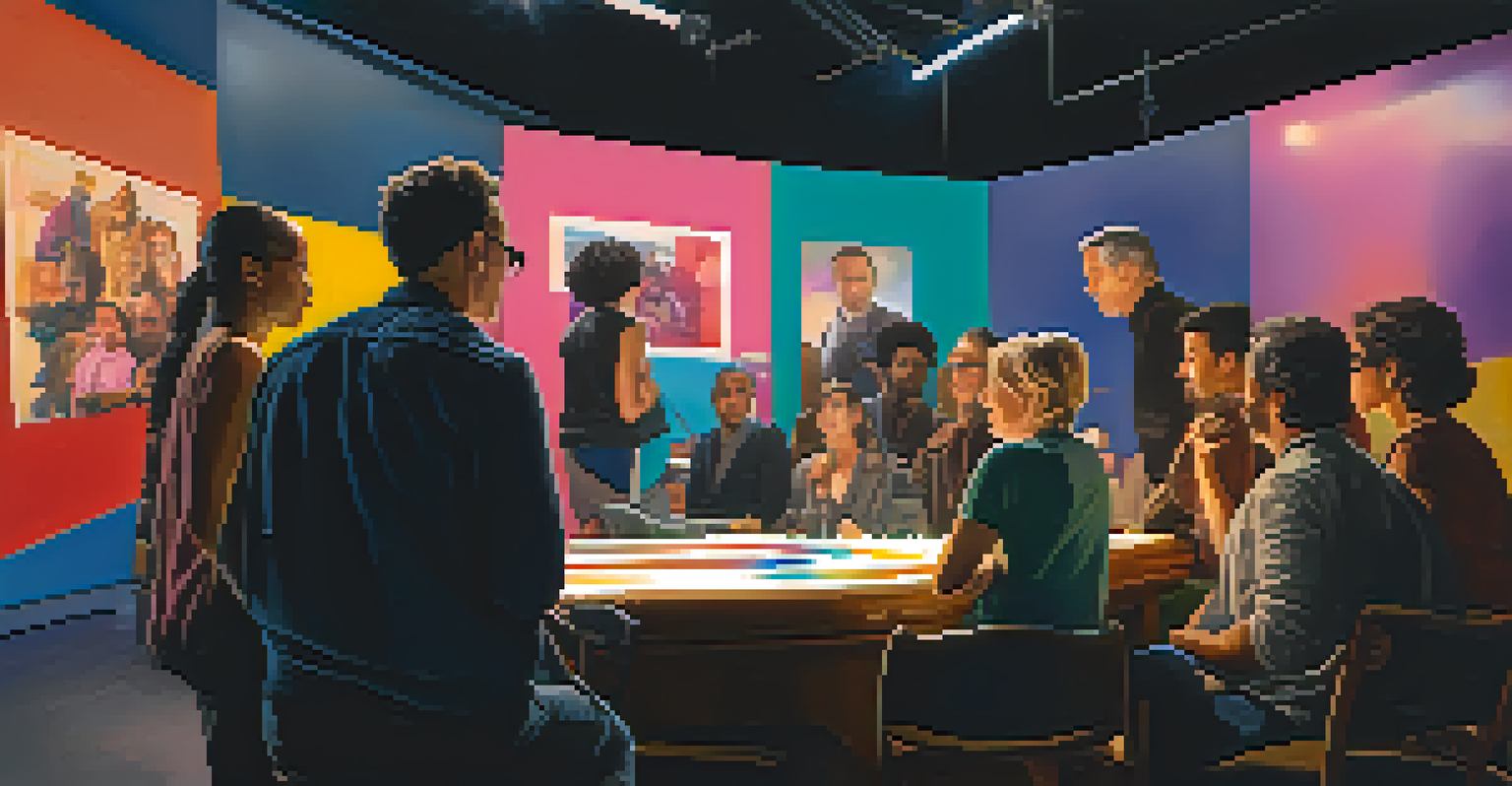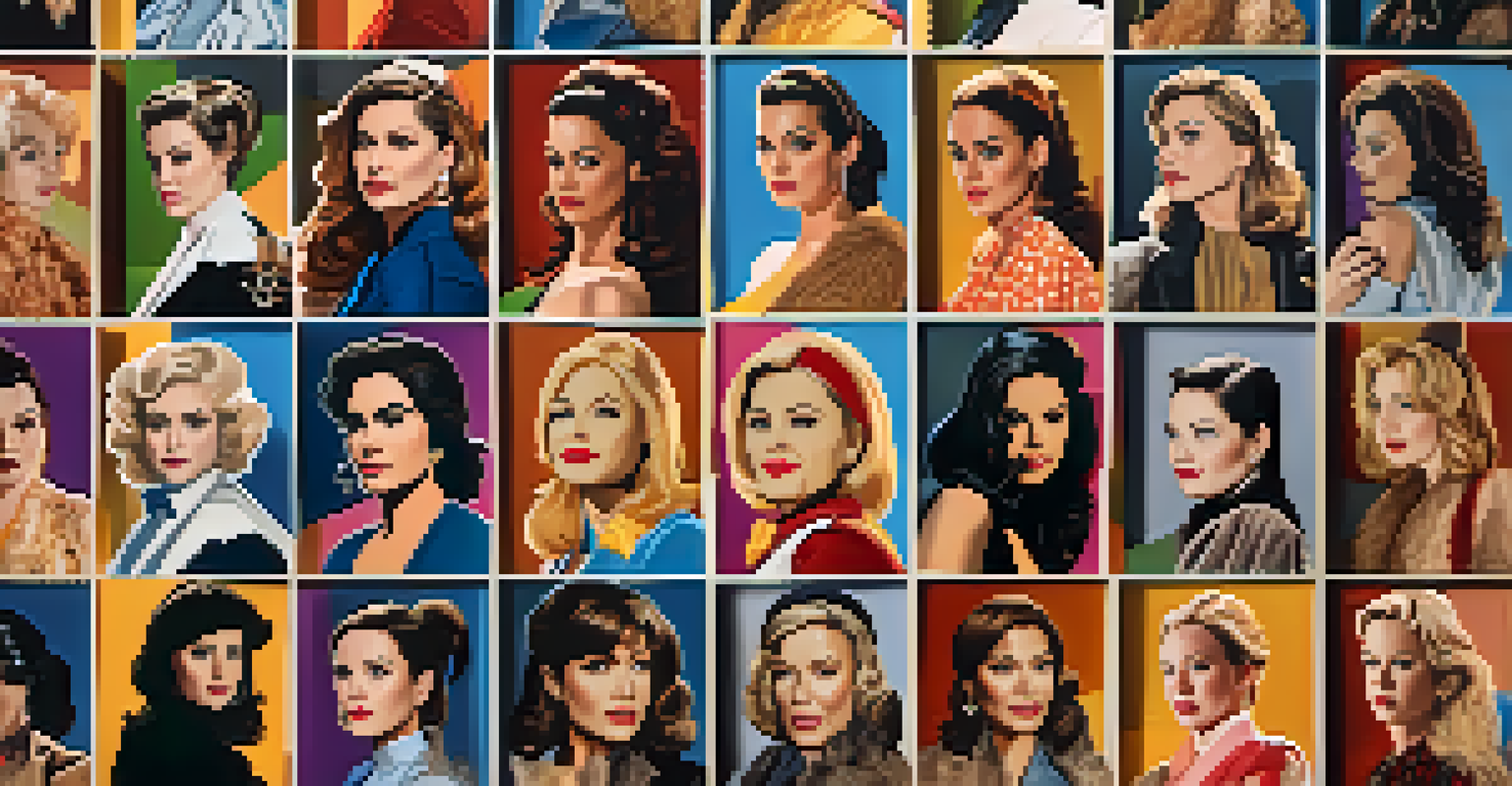Examining Gender Stereotypes in Classic Hollywood Cinema

Understanding Gender Stereotypes in Film
Gender stereotypes in film refer to the oversimplified and widely held beliefs about the roles and behaviors of men and women. In classic Hollywood cinema, these stereotypes were often reinforced through character portrayals and narratives. For instance, women were frequently depicted as nurturing and passive, while men were portrayed as strong and assertive, reflecting societal norms of the time.
The media can influence our views, but we must also recognize that it mirrors society's own values and beliefs.
These stereotypes not only influenced how audiences viewed gender roles but also shaped the opportunities available to actors and filmmakers. Female characters were often relegated to supporting roles or romantic interests, limiting their complexity and depth. This narrow representation created a cycle where audiences expected to see certain portrayals, which in turn affected the types of stories being told.
The impact of these stereotypes continues to resonate today, as many films still echo the tropes established in the past. By examining these representations, we can better understand the cultural contexts that shaped them and the ongoing challenges in achieving gender equality in cinema.
The Role of Women in Classic Hollywood
In classic Hollywood, women were often cast into specific roles that adhered to societal expectations. The 'damsel in distress' archetype was particularly prevalent, where female characters needed saving by male heroes. This not only limited the narrative possibilities for women but also reinforced the idea that women were dependent on men for their happiness and safety.

Moreover, the portrayal of women as either virtuous or villainous added to the simplistic view of female identity. For instance, characters like Scarlett O'Hara from 'Gone with the Wind' embodied both strength and manipulation, yet still fell into the overarching narrative of needing a man's validation. Such duality often confused the audience's perception of female empowerment, as it was entwined with traditional femininity.
Gender Stereotypes Persist in Film
Classic Hollywood reinforced gender stereotypes that continue to influence modern cinema and audience perceptions.
As we look back at these portrayals, it becomes evident that they contributed to the cultural narrative surrounding women's roles in society. By analyzing these characters, we can uncover the ways they impacted real-life perceptions of women and paved the way for future representations in film.
Male Archetypes and Their Influence
Male characters in classic Hollywood films often embodied ideals of masculinity that were rigid and unyielding. The 'strong, silent type' became a common trope, with heroes like John Wayne and Humphrey Bogart representing an archetype that valued toughness and emotional restraint. This portrayal not only defined how men were expected to act but also influenced audiences' perceptions of masculinity.
Cinema is a mirror by which we often see ourselves and society at large, and it can either reinforce or challenge our views on gender roles.
Additionally, these male archetypes often overshadowed more nuanced representations of men, leading to a narrow understanding of what it meant to be male. Characters were typically depicted as providers and protectors, which reinforced the idea that vulnerability was a weakness. Such portrayals created unrealistic standards for men, adding pressure to conform to these ideals.
As society evolves, the critique of these male stereotypes becomes increasingly important. By recognizing and challenging these outdated depictions, filmmakers can create more authentic and varied representations of masculinity that resonate with contemporary audiences.
The Impact of the Hays Code
The Hays Code, established in the 1930s, was a set of industry moral guidelines that significantly influenced film content during its enforcement. This code dictated what could and could not be shown on screen, effectively censoring depictions of sexuality and reinforcing traditional gender roles. As a result, filmmakers often resorted to subtlety or suggestive implications rather than direct portrayals of complex relationships.
This censorship limited the scope of storytelling, pushing filmmakers to conform to the ideals of the time. For women, this meant that their roles were often sanitized, focusing on purity and virtue rather than exploring their full humanity. The consequence was a generation of films that lacked depth in character development, particularly for female leads.
Women Were Limited to Narrow Roles
Female characters often occupied simplistic roles, reinforcing traditional norms and hindering their complexity in storytelling.
However, the eventual decline of the Hays Code opened the door for more progressive representations. As filmmakers began to challenge these restrictions, they had the opportunity to explore more diverse and realistic portrayals of gender, paving the way for the evolving landscape of modern cinema.
Revisiting Classic Films Through a Modern Lens
Revisiting classic films today allows us to critically assess the gender stereotypes that were prevalent at the time. By viewing these films with a contemporary perspective, we can identify the problematic portrayals and appreciate the progress made in gender representation. For instance, films like 'Casablanca' may still captivate audiences, but they also reveal the limitations placed on female characters.
This critical examination encourages discussions about how far we've come and the work still needed to achieve true equality in film. By analyzing these classic narratives, we can highlight the contrast between past and present portrayals of gender, fostering a deeper understanding of societal changes. This dialogue is crucial for filmmakers and audiences alike, as it shapes the future of storytelling.
Furthermore, engaging with these films can stimulate interest in creating new narratives that defy traditional stereotypes. Filmmakers today have the opportunity to craft stories that offer more authentic and diverse representations, contributing to a richer cinematic landscape.
The Evolution of Gender Roles in Cinema
The evolution of gender roles in cinema reflects broader societal changes over the decades. As movements for women's rights gained momentum, films began to respond by showcasing stronger, more independent female characters. The 1970s and 1980s, in particular, saw the rise of the 'feminist film,' which challenged traditional narratives and sought to redefine women's roles on screen.
This shift was not without its challenges, as filmmakers had to navigate the backlash against progressive representations. However, the introduction of complex female characters, like those in 'Thelma & Louise' or 'Alien,' demonstrated that audiences were ready for more diverse narratives. These films not only entertained but also sparked conversations about gender equality and empowerment.
Evolving Narratives Challenge Norms
The rise of independent films and changing audience expectations are paving the way for more authentic and diverse gender representations.
As we continue to witness changes in the film industry, it's essential to recognize the lessons learned from past representations. Understanding how gender roles have evolved helps us appreciate the ongoing efforts to create inclusive and representative cinema that reflects the diversity of real life.
The Future of Gender Representation in Film
Looking ahead, the future of gender representation in film is promising yet requires ongoing commitment. With the rise of independent filmmakers and streaming platforms, there are more opportunities for diverse voices to be heard. This shift allows for a wider range of stories that challenge traditional gender stereotypes and offer fresh perspectives on identity.
Moreover, audience demand for authenticity is pushing filmmakers to prioritize representation in their narratives. Films that feature strong, complex characters regardless of gender are becoming more commonplace, reflecting a societal desire for inclusivity. This change not only appeals to modern viewers but also enriches the storytelling landscape.

Ultimately, the journey towards equitable gender representation in film is ongoing. By continuing to engage with and critique cinematic portrayals, we can ensure that future films reflect the diversity and complexities of human experience.